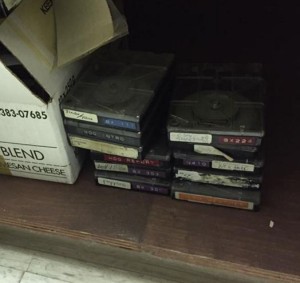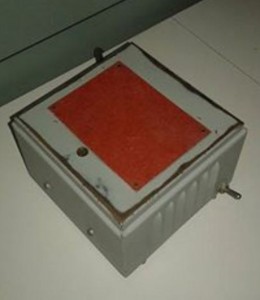Like music played on wax cylinders, records, 8-tracks, cassettes and CDs, audio for radio has gone through an evolution over the years. When I started my career, we still used reel-to-reel tapes and carts. Music, commercials and show segments were recorded onto carts. They look like 8-tracks but they’re not the same thing.
I discovered this stack of old carts at CJBK.
 Carts are simply plastic housings for lengths of reel-to-reel tape wound onto a mechanism that allows them to play in a loop. If you have a three-minute song, you make the cart 3:10 so as soon as it ends, it cues up to the start and it’s ready to play again. A special tone is recorded onto the tape so it knows when to stop. You can also apply other tones that will light up the cart machine’s buttons and alert you that the song is coming to an end.
Carts are simply plastic housings for lengths of reel-to-reel tape wound onto a mechanism that allows them to play in a loop. If you have a three-minute song, you make the cart 3:10 so as soon as it ends, it cues up to the start and it’s ready to play again. A special tone is recorded onto the tape so it knows when to stop. You can also apply other tones that will light up the cart machine’s buttons and alert you that the song is coming to an end.
A newscaster would hand you a stack of these things, each with a bit of audio that corresponded to their stories. Everyone dropped them at some point, and scrambled to get them back in order before the top of the hour.
They were also a favourite projectile for the stressed-out among us. You’d see one coming and duck just in time. It would shatter against the wall. I worked with two childish talk show hosts in Hamilton who used to erase each other’s carted commentary and then claim ignorance as to how it happened.
Which brings us to erasing. When I started college at Niagara, the second-year broadcasting students warned us about the upcoming “bulk erasing test”. They were preying on our lack of knowledge for their own amusement. Bulk erasing was a simple but boring task. This is a bulk eraser.
You flip the switch to fire it up and rub the cart back and forth on the top until the recording is gone. If you didn’t do it properly, sometimes a faint version of the old recording could be heard under the new recording and you’d have to start all over again.
There were all sorts of pitfalls with carts. If you didn’t bother to locate the tape splice, you’d end up with a “drop out” in the audio. The tape eventually wore out and the sound quality would drop. You wouldn’t know it until the cart was played on air, and there was always one, final, awful play before a cart was “pulled”. They were tedius to make and maintain but they were all we had at the time.
Radio is less tactile now. Everything is digital. There’s no need to mark tape with a grease pencil, cut it with a razor and tape it expertly so there’s no gap. I loved that whole process but things are definitely better now.

